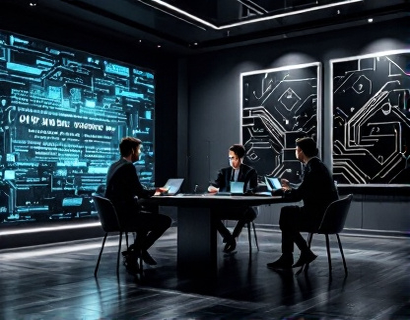Transforming Cinema Knowledge Access: The Rise of AI-Powered Chat Interfaces
The film industry, a rich tapestry of art, culture, and entertainment, has always been a source of fascination for people worldwide. However, accessing in-depth knowledge about cinema can often be a daunting task, especially for those who are new to the industry or seeking educational resources. The advent of AI-powered chat interfaces is revolutionizing this landscape, offering a safe, interactive, and engaging way to explore the world of cinema. This article delves into how these innovative tools are transforming the way we learn about and interact with cinema, catering to a diverse audience ranging from children and students to film enthusiasts and professionals.
The Need for Accessible Cinema Knowledge
Traditionally, gaining specialized knowledge about cinema has required extensive research, visits to libraries, or attending lectures and workshops. While these methods are effective, they often present barriers such as time constraints, geographical limitations, and the overwhelming amount of information available. The introduction of AI chat interfaces addresses these challenges by providing a user-friendly platform where users can interact directly with a wealth of cinema-related data. These interfaces are designed to deliver accurate, relevant, and engaging content, making cinema knowledge more accessible than ever before.
Ensuring Safety in Cinema Knowledge Access
One of the most significant advantages of AI-powered chat interfaces in the context of cinema knowledge is their focus on safety. Content verification is a critical component, ensuring that the information provided is accurate and trustworthy. This is particularly important for younger users who may not have the critical skills to discern reliable sources from unreliable ones. By implementing robust content verification processes, these chat interfaces protect users from misinformation and provide a secure environment for learning.
Additionally, a child-friendly mode is an essential feature for making cinema knowledge accessible to children and students. This mode adjusts the language, complexity, and content to be age-appropriate, ensuring that young users can explore the world of cinema without encountering inappropriate material. The combination of content verification and a child-friendly mode makes these chat interfaces an ideal resource for educational settings, where safety and accuracy are paramount.
Specialized Knowledge for Diverse Audiences
AI chat interfaces in cinema are designed to cater to a wide range of users, each with their unique interests and levels of expertise. For children, the interface can provide basic information about favorite movies, characters, and genres, sparking a love for cinema from a young age. Students can delve deeper into topics such as film history, directors, and cinematic techniques, enhancing their educational experience. Film enthusiasts and professionals can access detailed analyses, industry trends, and behind-the-scenes insights, enriching their understanding and appreciation of cinema.
Moreover, the chat interfaces can offer personalized recommendations based on user preferences and interactions. This personalized approach not only makes the learning experience more engaging but also helps users discover new films and aspects of the industry they might not have considered otherwise. Whether it's learning about the art of cinematography, the evolution of special effects, or the business side of film production, these chat interfaces provide a comprehensive and tailored educational experience.
Interactive and Engaging Learning Experiences
The interactive nature of AI chat interfaces transforms the way users engage with cinema knowledge. Unlike traditional learning methods, these interfaces allow users to ask questions, receive immediate feedback, and explore topics in a conversational manner. This dynamic interaction makes the learning process more enjoyable and effective, as users can actively participate in their education.
For example, a user might start by asking about the plot of a classic film and, based on the response, request more information about the director's other works or the historical context in which the film was made. The chat interface can seamlessly provide this additional information, creating a rich and interconnected learning experience. This level of interactivity not only keeps users engaged but also encourages deeper exploration and a more profound understanding of the subject matter.
Enhancing Educational Value for Students and Educators
In the educational sector, AI chat interfaces can serve as valuable tools for both students and educators. For students, these interfaces can complement classroom learning by providing supplementary information and resources. Teachers can integrate these chat interfaces into their lesson plans, using them to answer student questions, facilitate discussions, and assign research tasks. The accuracy and reliability of the information ensure that students are learning from a trustworthy source.
For educators, these chat interfaces offer a new way to stay updated on the latest trends and developments in the film industry. By interacting with the chat, educators can gain insights into current cinematic techniques, popular genres, and emerging filmmakers. This continuous learning helps educators provide more relevant and engaging content to their students, fostering a more dynamic and informative learning environment.
Promoting Inclusivity and Diversity
One of the most compelling aspects of AI chat interfaces in cinema is their potential to promote inclusivity and diversity. By providing information in multiple languages and catering to users with different learning styles, these interfaces break down barriers and make cinema knowledge accessible to a global audience. Users from diverse cultural backgrounds can explore films and concepts from around the world, gaining a broader perspective on the industry.
Moreover, the chat interfaces can highlight underrepresented voices and stories in cinema, bringing attention to films and filmmakers who might otherwise be overlooked. This focus on diversity not only enriches the user's understanding of the industry but also contributes to a more inclusive and representative cultural landscape.
Technological Innovations and Future Prospects
The development of AI chat interfaces for cinema knowledge access is just the beginning. As technology continues to advance, we can expect even more sophisticated and intuitive interactions. Natural language processing (NLP) improvements will enable chat interfaces to understand and respond to more complex queries, providing even more detailed and nuanced information. Integration with virtual and augmented reality technologies could create immersive learning experiences, allowing users to "step into" a film set or explore a virtual museum of cinema history.
Additionally, machine learning algorithms can be used to analyze user interactions and preferences, further personalizing the learning experience. Over time, these chat interfaces will become more adept at anticipating user needs and providing proactive recommendations, making the learning process even more seamless and effective.
Conclusion
The integration of AI-powered chat interfaces in cinema knowledge access represents a significant leap forward in how we engage with and learn about the film industry. By ensuring safety, providing specialized and accurate information, and offering interactive and personalized experiences, these interfaces are democratizing access to cinema knowledge. Whether you are a child discovering your first favorite movie or a professional delving into the intricacies of film production, these chat interfaces offer a safe, engaging, and enriching way to explore the world of cinema. As technology continues to evolve, the potential for these interfaces to transform cinema education and appreciation is immense, paving the way for a more informed and passionate global audience.










































